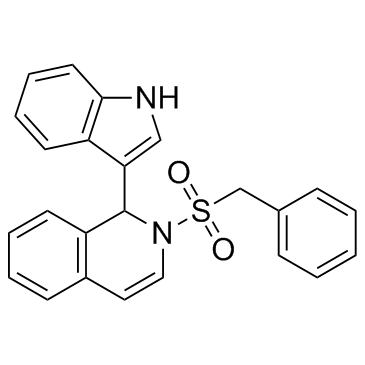IBR2
Modify Date: 2024-01-02 20:08:01

IBR2 structure
|
Common Name | IBR2 | ||
|---|---|---|---|---|
| CAS Number | 313526-24-8 | Molecular Weight | 400.4928 | |
| Density | N/A | Boiling Point | N/A | |
| Molecular Formula | C24H20N2O2S | Melting Point | N/A | |
| MSDS | N/A | Flash Point | N/A | |
Use of IBR2IBR2 is a specific RAD51 inhibitor. |
| Name | Isoquinoline, 1,2-dihydro-1-(1H-indol-3-yl)-2-[(phenylmethyl)sulfonyl]- |
|---|---|
| Synonym | More Synonyms |
| Description | IBR2 is a specific RAD51 inhibitor. |
|---|---|
| Related Catalog | |
| Target |
RAD51[1] |
| In Vitro | IBR2 shows interesting RAD51 inhibition activities. RAD51 is rapidly degraded in IBR2-treated cancer cells, and the homologous recombination repair is impaired, subsequently leading to cell death. The IC50 values of the original IBR2 are in the range of 12-20 µM for most tested cancer cell lines. IBR2 can inhibit the growth of triple-negative human breast cancer cell line MBA-MD-468 with an IC50 of 14.8 µM[1]. |
| Cell Assay | Human breast cancer cell lines MCF7, MDA-MB-231, MDA-MB-361, MDA-MB-435, MDA-MB468, Hs578-T, human osteosarcoma cell line U20S, human glioblastoma cell line T98G and human cervical adenocarcinoma cell line HeLa are used. Standard XTT assays with a four-day drug treatment procedure are performed to measure the dose dependent cytotoxicity of IBR analogs in cultured cells. In brief, cells are plated on 96-well dishes one day before the drug treatment, followed by drug (e.g., IBR2) treatment on day 2 and XTT assay on day 6 after drug addition by using a commercial cell proliferation kit . Triplicate sets are measured and compiled for final data presentation[1]. |
| References |
| Molecular Formula | C24H20N2O2S |
|---|---|
| Molecular Weight | 400.4928 |
| Storage condition | 2-8℃ |
| IBR2 |